End of the Edit
For the present generation of crime writers who cope with the baffling complexities of modern technology and can actually get Windows 10 to work, it is not a problem, but writers of a previous era have always had to face the vexing question of what to do with all those bulky typed (or even hand-written) manuscripts once a novel has been published. I know of many an author’s loft or attic space which would be deemed a fire hazard by an overzealous officer of the Health & Safety [Gone Mad] Police due to bundles of crisp, yellowing papers secured by industrial-strength rubber bands.
Having recently edited Youngman Carter’s anthology Tales on the Off-Beat for Ostara Publishing, mostly from delicate, typed carbon “flimsies” (as we used to call them at the Colonial Office), I was faced with the problem of what to do with the original manuscript, now over fifty years old. Fortunately, the Margery Allingham Archive at the Albert Sloman Library at the University of Essex also curates the papers of her widower, Pip Youngman Carter.
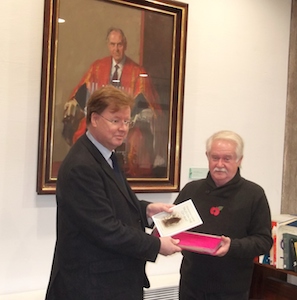 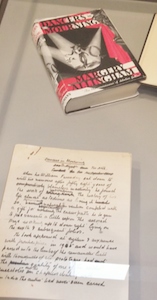
So it was a happy chore to return to the university (where I once worked for its inaugural Vice-Chancellor Dr Sloman – seen in the imposing portrait above) to officially hand over Youngman Carter’s manuscript to Deputy Librarian Nigel Cochrane and to get a sneak preview of some of the material the library will be placing in an exhibition to commemorate the fiftieth anniversary of the death of Margery Allingham in June 2016.
Close Encounters/Near-Misses
Following on from last month’s inauguration of a segment dedicated to close encounters or near-misses with famous crime writers, I am grateful to Len Deighton for providing the following example.
In 1969, when Len was elected to the elite Detection Club, the then President, Agatha Christie, welcomed him with the words: “I don’t believe we’ve met, Mr Deighton.” Len was able to reply that actually they had, in the 1950s, when he had been the steward who had served her coffee on a BOAC Lockheed Constellation flying from Heathrow to Beirut.
Dame Agatha’s reaction is not recorded and I am unsure as to whether she ever got to use the incident in one of her plots.
And I have experienced a near-miss (of sorts) myself by not attending the Publishers Publicity Circle Christmas party for the first time in several decades. I had, of course, the perfect excuse. I was not invited.
Demon Dog Days
I can remember those heady days of the late 1980s when, in this country, mystery readers suddenly became aware of a positive tsunami of crime-writing talent surging across the Atlantic. Championed by Maxim Jakubowski at Murder One (and by John Williams and Julian Symons in various publications), it seemed as if there was a never-ending supply of great American writers waiting to be discovered: Elmore Leonard, George V. Higgins, James Crumley, James Hall, James Lee Burke and James Ellroy. Not all of them were instant best-sellers; in fact initially most were received by small, but very enthusiastic, readerships, despite rave reviews.
Of that talented wave of Americans of the hard-boiled school, the most outrageous (in several ways) was James Ellroy, not the least because he seemed to be determined to be outrageous in both his writing and the public persona he adopted, the latter which lead to his own description as ‘the demon dog’ and often involved very public outbursts of howling at an imaginary moon.

That epithet has now been adopted by Steven Powell of Liverpool University in his forensic critique James Ellroy: Demon Dog of Crime Fiction (Palgrave Macmillan), which tracks Ellroy’s writings from his early attempts at mainstream private eye novels to his famous ‘L.A.’ Quartet (though that probably should be Quartets now) and his – some would say rather overblown – ‘Underworld USA’ trilogy.
I discovered Ellroy the writer through the famous Murder One bookshop in about 1987 by buying an American paperback edition of Blood on the Moon, which I thought was a terrific rogue-cop-versus-demented-serial-killer thriller (I also liked the film version, Cop starring the awesome James Woods, though I do not think James Ellroy did). I was equally impressed with Silent Terror, his ‘road movie’ take on serial killers and then came The Black Dahlia and the rest rapidly became history.
I first met Ellroy in London, aptly enough at a Murder One party, during the 1990 Bouchercon festivities. He was quite an imposing figure: tall, lean and wearing, for no good reason, full formal Highland dress – though no one dared to ask which tartan his kilt was made of. To be honest, no one at that party dared say anything much to him as he concentrated on signing a pile of his own books inhisown inimitable way, often suggesting unusual forms of behaviour to the unwary purchaser.
In his new study, Steven Powell charts Ellroy’s early career and influences as a writer. Much of Ellroy’s personal back story is well-known; he has made sure of that. What I had not fully realised was the importance in his career of editor Otto Penzler and agent Nat Sobel, who took on Ellroy as a client when he had “had two paperback originals published and his agent had given up on him” and helped turn Blood on the Moon into a publishable book, it having been turned down by more than a dozen publishers.
James Ellroy: Demon Dog of Crime Fiction looks in great depth at Ellroy’s fiction, carefully picking out cogent threads in its development, and even attempting to make sense of White Jazz, which baffled us lesser mortals who read the uncorrected proof version back in 1992. He was, and continues to be,a writer who splits opinions but as the author of several excellent thrillers and the outstanding achievement that was the ‘L.A. Quartet’, who has honed his own, unique, narrative ‘voice’, Ellroy is well-worth such a rich critical study. Only the price - £58 – will put off true fans of his novels, to which Steve Powell’s book is an invaluable companion.
Double Indemnity?
The concept of the (female) ‘unreliable narrator’ is undoubtedly a publishing flavour of the month and next year we may (I say ‘may’ as I haven’t read it yet) see the idea extended into an elaborate double-bluff in the debut thriller from Germany’s Melanie Raabe, The Trap, to be published by Mantle in May 2016.
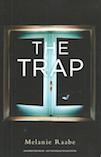 
The set-up is certainly intriguing. Linda Conrads’ sister is murdered and her killer is never caught, but Linda has seen him and years later sees him again, on television, where he has become a well-known reporter and interviewer. So Linda writes a thriller – Blood Sisters – about a woman who is murdered and her killer never caught, and then agrees to give just one media interview to…guess who? Thus the ‘fictional’ novel Blood Sisters (if you see what I mean) sets The Trap of Melanie Raabe’s novel. Film rights, as you might guess, have already been snapped up
Melanie, I believe, lives in Cologne and has a ‘Twitter Feed’ – whatever that is – which claims that she ‘Puts the Mel in Melodramatic’.
Another resident of Cologne was in London last month in advance of the publication of his first crime novel to be translated into English next year.
At a splendid luncheon organised by publisher Bitter Lemon, the voluptuous Ayo Onatade, distinguished cosmopolitan Marcel Berlins, Professor Barry Forshaw and my humble self had the pleasure of meeting the charming Mario Giordano, author of Aunt Poldi and the Sicilian Lions, for which we will sadly have to wait until September 2016.

Although born in Munich and an established author and screenwriter in Germany, Mario’s name and the title and setting of his comic crime debut betray his Italian origins. Already successful in Germany, Giordano’s tales of ‘Tante Poldi’ might just have their foundation in his family history, though one doesn’t like to pry too much.

Suffice it to say that Aunt Poldi sounds as if she has all the makings of a great character set for a long-running series. On her 60th birthday, the widow Isolde ‘Poldi’ Oberreiter decides to leave Bavaria for Sicily, where she intends to sit in the sun an drink herself to death, and she sets to it with a will and a regime which includes ‘a prosecco to wake up, then an espresso with a shot of grappa, followed – at 11 a.m. – with the first wheat beer of the day.’
As the character ‘Animal’ from The Muppets once said of Rita Moreno after a particularly sultry rendition of ‘Fever’: “My kinda woman…” {For younger readers unfamiliar with the classics, I recommend a viewing on: https://goo.gl/o8dTLA}
Busy Busy
It is possible that CWA supremo and Detection Club stalwart Len ‘L.C.’ Tyler could be in the running for the title ‘Hardest Working Crime-Writer’ (if there was such a thing) of 2016.

Perhaps working on the theory that the rest of the year will then be his own, Len has two new novels out in the first two months of the new year; the historical thriller A Masterpiece of Corruption (from Constable) in January followed rapidly by one of his humorous cosy mysteries Cat Among the Herrings (from Allison & Busby) in February.
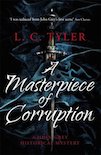 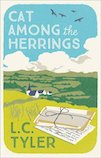
However, Len may have a rival for the ‘Hardest Working’ award (which does not exist, though it probably will) as American bestseller James Patterson has three titles listed for publication in January, February and April. (He clearly decided to take March off.) As these, however, are co-authored with Mark Sullivan, Maxine Paetro and Marshall Karp, I am not sure they qualify.
Whilst maths was never my strong point, I believe James Patterson has authored (or at least his name appears on the cover of) around 144 books so far, not including graphic novels, which probably gives him the edge.
Reviewing the Reviewer
As a young ingénue member of the Crime Writers’ Association (my status both as ingénue and member were short-lived), I had a rule that whenever I met a crime-writer new to me, I would make sure I had read one of their novels before I saw them again. I stuck to this Lebensregel for many years until world-weariness and a growing cynicism about how young the crime-writers were getting, resulted in my abandoning the ritual.
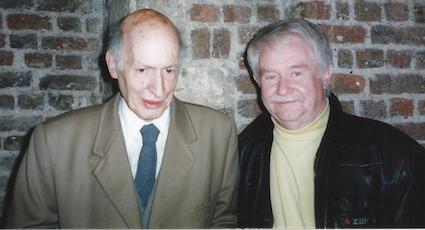
I regretted the fact on the occasion that I met legendary critic Anthony Lejeune some years ago as he was celebrating fifty years (yes, fifty) as a reviewer of crime fiction for the Catholic weekly newspaper The Tablet. I knew Anthony had written a series of crime novels and had a series hero known as ‘The Professor’ – although I do not believe these to be based on Barry Forshaw – but I had never read one, and what I should have done was remedy that omission at the time.
Far too long after the event, I now intend to for I have come across a short series of spy novels written by Anthony Lejeune in the early 1960s and thanks to a super-efficient thrift store in North Carolina, I will be savouring his Death of a Pornographer, from 1965, this Christmas.
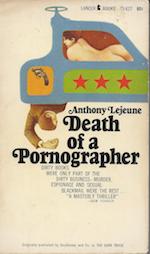
By rights, I suppose I should read it seated in a large leather armchair in the oak surroundings of an ancient Gentlemen’s Club, as Anthony was an acknowledged expert and author on the history of London’s Clubland.
|
|
What’s New?
Over a very pleasant lunch a while ago, I discovered that American best-seller Lisa Gardner takes her thriller-writing very seriously, especially when it comes to the subjects she chooses for her plots, most of which are ripped from the headlines where they are for all the wrong reasons.
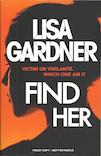
Lisa has a new book, Find Her, out here from Headline in February which concerns a girl who has been abductedand held by her captor for 472 days, but once found, does she remain a victim or turn vigilante?
That Find Her will be yet another success for Lisa Gardner is not in itself news, but the appearance of the first ever Estonian crime novel to be published in the UK surely is.
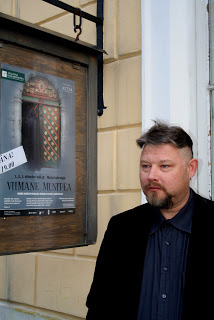 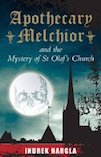
And even more newsworthy is the fact that it is a medieval mystery, ideal for students of Christianity in 15th century Reval, now better known as Tallinn, a town which, for its size, boasts a suspiciously high number of bars and night clubs. The Mystery of St Olaf’s Church by Indrek Hargla (above) is the first of a series of mysteries to feature Apothecary Melchior Wakenstede. There are four already published, plus talk of a film and a TV series, back in Estonia but this first outing in English is from publisher Peter Owen.
Should anyone think that Melchior Wakenstede an unusual name for a fictional hero, then how about special agent Aloysius Xingu Lilius Pendergast (I am not sure I’ve got that exactly right)? Pendergast is the central character of the fantastical thrillers jointly written, with great gusto, by Douglas Preston and Lincoln Child.
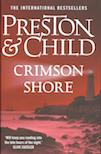
Their, and Prendergast’s, latest adventure Crimson Shore, set on the sooky coats of Massachusetts, is published this month by Head of Zeus.
What’s Old?
Those energetic people at Dean Street Press seem to have absolutely no trouble finding ‘lost’ detective stories for the so-called ‘Golden Age’ – a seam which apparently has no intention of ever running dry.
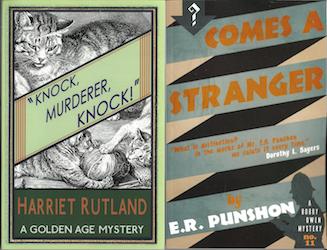
Their latest releases include the only three novels by Harriet Rutland (no, me neither): Knock, Murderer, Knock!, Bleeding Hooks and Blue Murder which were first published between 1938 and 1942.
Dean Street have also extended their republication of the rather better-known E.R.Punshon’s ‘Bobby Owen’ series with five more titles from the period 1938-1941: Comes A Stranger, Suspects-Nine, Murder Abroad, Four Strange Women and Ten Star Clues.
As editor of the Top Notch Thriller imprint at Ostara, I cannot resist (in fact I am probably contractually obliged) mentioning our latest reissues:

Reg Gadney’s debut thriller Drawn Blanc from 1970 is a Kafka-esque take on the bleak world of the British secret service at the fag-end of the 1960s as it tries to reconstruct itself in the aftermath of the Philby defection to Moscow. A noted artist as well as a writer, the cover shows Turning Head from Reg’s latest exhibition of portrait paintings.
Raymond Hitchcock (1922-1992) was an artist who turned to writing thrillers and The Tunnellers, first published in 1986, is a poignant tale of the young ‘Sappers’ (Hitchcock himself served in the Royal Engineers during WWII) who fought in the trenches, or rather under them, on the Western Front in 1917, laying massive mines under enemy positions.
What’s Old and New
Titan Books’ Hard Case Crime imprint has an excellent track record in finding not just ‘lost’ thrillers but crime novels which have been actively ‘disappeared’. Their latest revival, available in January, is a very early Ed McBain novel, Cut Me In, from 1954 when it was first published under the pen-name Hunt Collins.
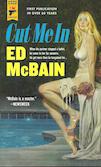
Now I did once meet the late Ed McBain (aka Evan Hunter, aka Salvatore Lombino) some years ago and the topic of getting his extensive backlist back into print came up. He struck me – judging by the way he lobbied his UK publisher who had introduced us – as an author who would have loved to see everything he had written back in print, so it is slightly strange that Cut Me In has remained out in the cold for sixty years. I am sure that fact has absolutely nothing to do with the plot of the novel, which revolves around the murder of a literary agent…
Available now is the 3-disc DVD Callan: This Man Alone which will tell the dedicated Callan fan just about as much – perhaps too much – as they ever wanted to know about the iconic television series which attracted huge ratings, and made national headlines not to mention a star of Edward Woodward between 1967 and 1972.
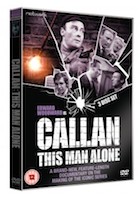
There are some nuggets of new information among the extensive interviews with surviving writers, directors and producers of the show; notably that James Mitchell’s original ‘pilot’ drama, A Magnum For Schneider, had been turned down – or at least ignored – by the BBC.
For the Callan fan who simply cannot get enough, Ostara Publishing are reissuing James Mitchell’s last two Callan novels – Smear Job and Bonfire Night in 2016.
The Year’s Picks
In line with Shots’ recent policy of not adding to the world surplus of crime fiction awards, there will be no official Shots-of-the-Year but my fellow staffers at Shots HQ could not resist picking our personal favourite reads of 2015.

And so, from the rooftop of Shots’ Abbey Road studios, here are our recommendations.
Ayo Onatade:
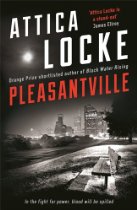 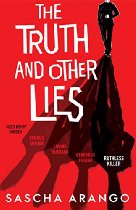 
Pleasantville by Attica Locke (Serpent's Tail). A highly accomplished political thriller about an incident in African American election history. Pleasantville depictsthe beginnings of the present implacable ideological standoff in US politics. Well written, fresh and with an oppressively edgy ambiance. Attica Locke channels bitter political memories into a taut and fascinating novel.
The Truth and Other Lies by Sascha Arango (Simon and Schuster). With a fine line between truth and fiction, The Truth and Other Lies introduces readers to an anti-hero who could easily be Tom Ripley’s double. An intriguing read with a twisty plot, this novel is full of irony, misdirection and black humour. The sheer audacity leaves you gasping for breath.
The Killing Kind by Chris Holm (Mulholland Books). A hitman killer with a difference? A hitman who only kills other hitmen. A hit man with a guilty conscience. Spare, ruthless and enthralling we have Hendricks who has his own moral code. With a lot of energy and told from several viewpoints, The Killing Kind is a well-constructed hardboiled thriller easily read in one sitting.
Mike Stotter:
  
Mockingbird Songs by R.J. Ellory (Orion). Ellory’s prose is evocative as ever as he tells the intriguing tale of Henry Quinn, ex-prisoner, helping out a cell mate’s request in delivering a letter to his daughter whom he has never met. Small town politics, desolate Texas landscape, dysfunctional families and memorable characters make this a particular favourite.
Fatale by Jean-Patrick Manchette (Serpent’s Tail). A noir novella that packs a surreal tone that had me hooked from the start. Bleak, stripped down writing and almost film-like in structure. Superbly observed characters throughout; especially Aimee – the professional blackmailer/ killer (the femme fatale of the book).
Hold The Dark by William Giraldi (No Exit). A combination of primeval violence and the merciless Alaskan tundra winter lifts this thriller above the norm. When wolves take three children from their isolated village, one of the mothers calls in Russell Core – writer and wolf expert. What he uncovers shakes him to his core. Nature here is the main character.
Myself:
  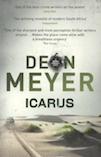
Without the Moon by Cathi Unsworth (Serpent’s Tail). Wonderfully evocative serial killer mystery set in wartime London, convoluting two actual murder cases and spicing with fantastic characters real and fictional. Descriptive prose which reeks of dust from bomb damage and stale cigarette smoke.
Tin Sky by Ben Pastor (Bitter Lemon). World War II again but this time the vast Eastern front and the very deadly choices facing the decent, aristocratic, Catholic Wehrmacht officer Martin von Bora. A soldier with a conscience fighting an unconscionable war and forced to keep one eye permanently over his shoulder.
Icarus by Deon Meyer (Hodder). Proof, if proof were needed, that South Africa’s Deon Meyer is now a world-class crime writer. His series detective Benny Griessel (struggling, and failing, not to fall off the wagon) is now a character the equal of Rankin’s John Rebus or Connolly’s Harry Bosch. In fact he may be edging ahead of that distinguished pack.
There will be more contributions over on the Blog when Prince Ali Karim comes into range from his boat currently sailing in the Antibes.
And Finally…

That’s almost it for 2015, apart of course from the traditional Christmas party at Heffers magnificent bookshop in Cambridge on Thursday 10th December, which this year is themed Murder Under the Mistletoe. An informal event where readers mingle with writers, this evening usually involves partaking of the first Mince Pie of the Season accompanied by (not necessarily the first) mulled wine.
As it’s Christmas, or nearly is, and it’s my column, I want to add one further reading recommendation: Dynasty by Tom Holland – The Rise and fall of the House of Caesar (Little Brown).
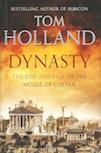
If you think that a narrative history of Ancient Rome, however well written (and it is well written), has no place being recommended by a magazine which specializes in stories of murder, mayhem, betrayal, corruption and political assassination, then you simply don’t know your Roman history.
Io Saturnalia!
Felix MMXVI
The Ripster
|